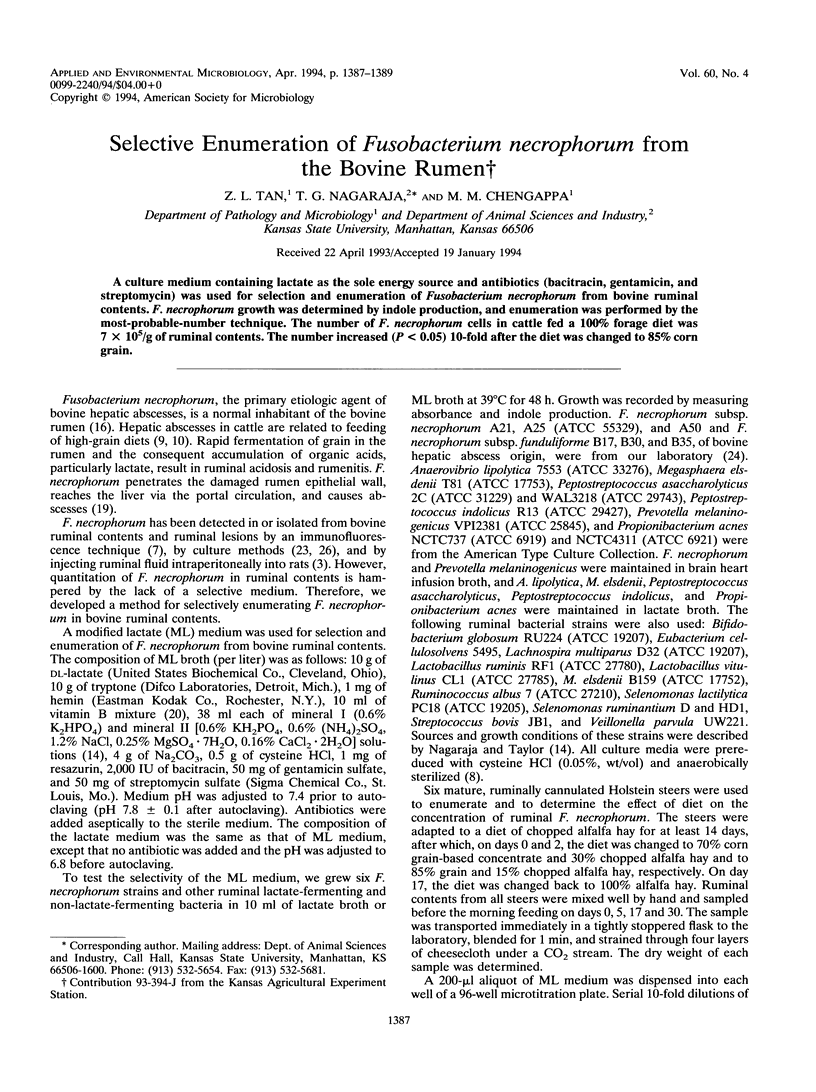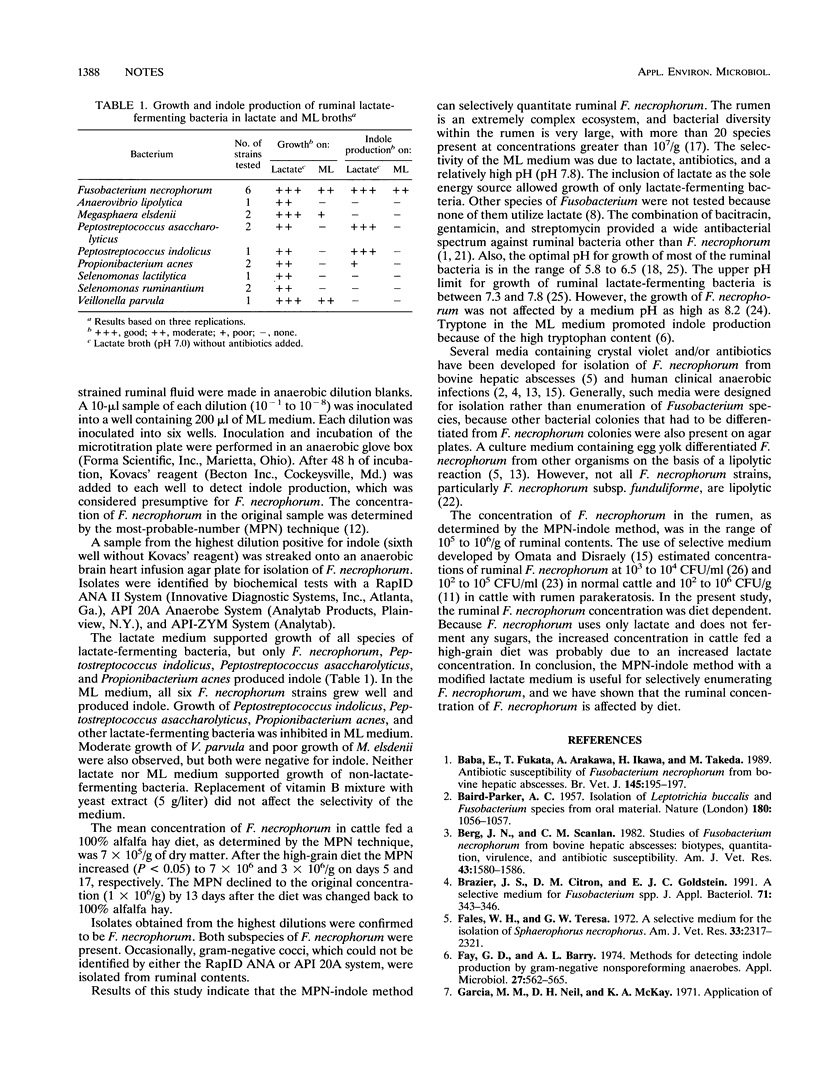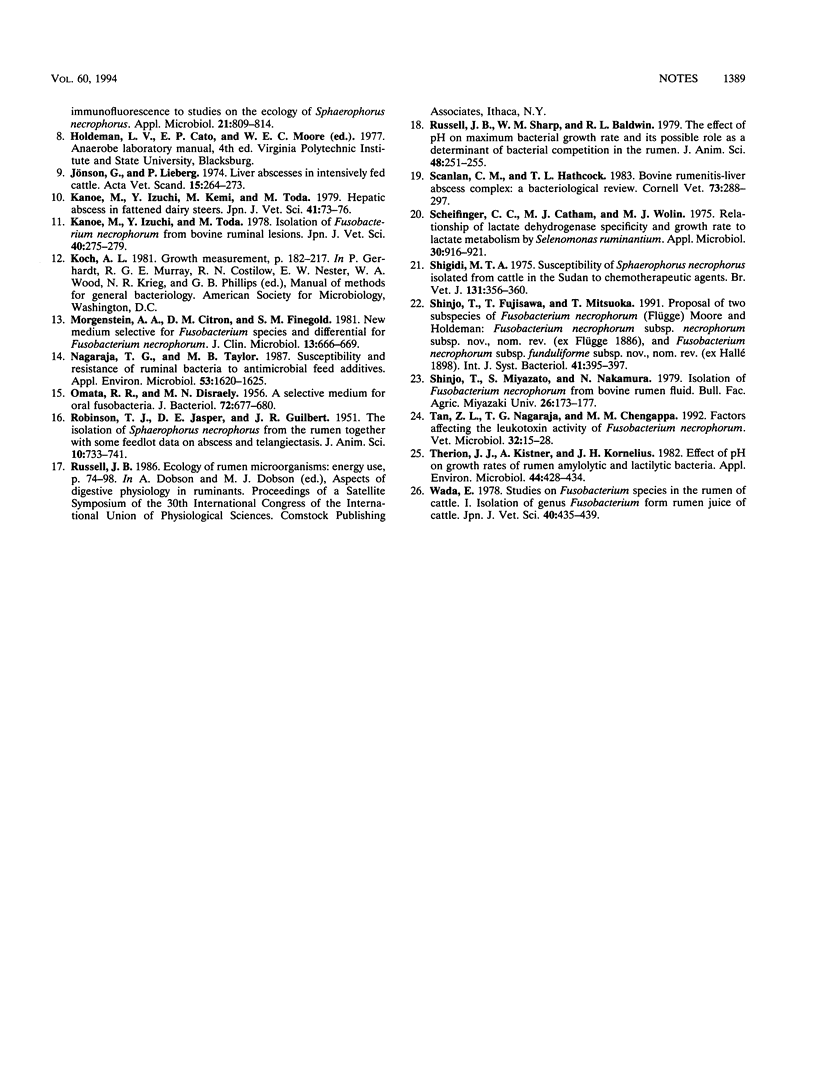Abstract
A culture medium containing lactate as the sole energy source and antibiotics (bacitracin, gentamicin, and streptomycin) was used for selection and enumeration of Fusobacterium necrophorum from bovine ruminal contents. F. necrophorum growth was determined by indole production, and enumeration was performed by the most-probable-number technique. The number of F. necrophorum cells in cattle fed a 100% forage diet was 7 x 10(5)/g of ruminal contents. The number increased (P < 0.05) 10-fold after the diet was changed to 85% corn grain.
Full text
PDF


Selected References
These references are in PubMed. This may not be the complete list of references from this article.
- BAIRD-PARKER A. C. Isolation of Leptotrichia buccalis and Fusobacterium species from oral material. Nature. 1957 Nov 16;180(4594):1056–1057. doi: 10.1038/1801056b0. [DOI] [PubMed] [Google Scholar]
- Baba E., Fukata T., Arakawa A., Ikawa H., Takeda M. Antibiotic susceptibility of Fusobacterium necrophorum from bovine hepatic abscesses. Br Vet J. 1989 Mar-Apr;145(2):195–197. doi: 10.1016/0007-1935(89)90105-X. [DOI] [PubMed] [Google Scholar]
- Berg J. N., Scanlan C. M. Studies of Fusobacterium necrophorum from bovine hepatic abscesses: biotypes, quantitation, virulence, and antibiotic susceptibility. Am J Vet Res. 1982 Sep;43(9):1580–1586. [PubMed] [Google Scholar]
- Brazier J. S., Citron D. M., Goldstein E. J. A selective medium for Fusobacterium spp. J Appl Bacteriol. 1991 Oct;71(4):343–346. doi: 10.1111/j.1365-2672.1991.tb03798.x. [DOI] [PubMed] [Google Scholar]
- DISRAELY M. N., OMATA R. R. A selective medium for oral fusobacteria. J Bacteriol. 1956 Nov;72(5):677–680. doi: 10.1128/jb.72.5.677-680.1956. [DOI] [PMC free article] [PubMed] [Google Scholar]
- Fales W. H., Teresa G. W. A selective medium for the isolation of Sphaerophorus necrophorus. Am J Vet Res. 1972 Nov;33(11):2317–2321. [PubMed] [Google Scholar]
- Fay G. D., Barry A. L. Methods for detecting indole production by gram-negative nonsporeforming anaerobes. Appl Microbiol. 1974 Mar;27(3):562–565. doi: 10.1128/am.27.3.562-565.1974. [DOI] [PMC free article] [PubMed] [Google Scholar]
- Garcia M. M., Neil D. H., McKay K. A. Application of immunofluorescence to studies on the ecology of Sphaerophorus necrophorus. Appl Microbiol. 1971 May;21(5):809–814. doi: 10.1128/am.21.5.809-814.1971. [DOI] [PMC free article] [PubMed] [Google Scholar]
- Jönsson G., Liberg P. Liver abscesses in intensively fed cattle. Serial investigations of serum proteins. Acta Vet Scand. 1974;15(2):264–273. doi: 10.1186/BF03547487. [DOI] [PMC free article] [PubMed] [Google Scholar]
- Kanoe M., Izuchi Y., Kemi M., Toda M., Hara Y. Hepatic abscess in fattened dairy steers. Nihon Juigaku Zasshi. 1979 Feb;41(1):73–76. doi: 10.1292/jvms1939.41.73. [DOI] [PubMed] [Google Scholar]
- Kanoe M., Izuchi Y., Toda M. Isolation of Fusobacterium necrophorum from bovine ruminal lesions. Nihon Juigaku Zasshi. 1978 Jun;40(3):275–281. doi: 10.1292/jvms1939.40.275. [DOI] [PubMed] [Google Scholar]
- Morgenstein A. A., Citron D. M., Finegold S. M. New medium selective for Fusobacterium species and differential for Fusobacterium necrophorum. J Clin Microbiol. 1981 Apr;13(4):666–669. doi: 10.1128/jcm.13.4.666-669.1981. [DOI] [PMC free article] [PubMed] [Google Scholar]
- Nagaraja T. G., Taylor M. B. Susceptibility and resistance of ruminal bacteria to antimicrobial feed additives. Appl Environ Microbiol. 1987 Jul;53(7):1620–1625. doi: 10.1128/aem.53.7.1620-1625.1987. [DOI] [PMC free article] [PubMed] [Google Scholar]
- Relationship of lactate dehydrogenase specificity and growth rate to lactate metabolism by Selenomonas ruminantium. Appl Microbiol. 1975 Dec;30(6):916–921. doi: 10.1128/am.30.6.916-921.1975. [DOI] [PMC free article] [PubMed] [Google Scholar]
- Russell J. B., Sharp W. M., Baldwin R. L. The effect of pH on maximum bacterial growth rate and its possible role as a determinant of bacterial competition in the rumen. J Anim Sci. 1979 Feb;48(2):251–255. doi: 10.2527/jas1979.482251x. [DOI] [PubMed] [Google Scholar]
- Scanlan C. M., Hathcock T. L. Bovine rumenitis - liver abscess complex: a bacteriological review. Cornell Vet. 1983 Jul;73(3):288–297. [PubMed] [Google Scholar]
- Shigidi M. T. Susceptibility of Sphaerophorus necrophorus isolated from cattle in the Sudan to chemotherapeutic agents. Br Vet J. 1975 May-Jun;131(3):356–360. doi: 10.1016/s0007-1935(17)35294-6. [DOI] [PubMed] [Google Scholar]
- Shinjo T., Fujisawa T., Mitsuoka T. Proposal of two subspecies of Fusobacterium necrophorum (Flügge) Moore and Holdeman: Fusobacterium necrophorum subsp. necrophorum subsp. nov., nom. rev. (ex Flügge 1886), and Fusobacterium necrophorum subsp. funduliforme subsp. nov., nom. rev. (ex Hallé 1898). Int J Syst Bacteriol. 1991 Jul;41(3):395–397. doi: 10.1099/00207713-41-3-395. [DOI] [PubMed] [Google Scholar]
- Tan Z. L., Nagaraja T. G., Chengappa M. M. Factors affecting the leukotoxin activity of Fusobacterium necrophorum. Vet Microbiol. 1992 Jul;32(1):15–28. doi: 10.1016/0378-1135(92)90003-c. [DOI] [PubMed] [Google Scholar]
- Therion J. J., Kistner A., Kornelius J. H. Effect of pH on growth rates of rumen amylolytic and lactilytic bacteria. Appl Environ Microbiol. 1982 Aug;44(2):428–434. doi: 10.1128/aem.44.2.428-434.1982. [DOI] [PMC free article] [PubMed] [Google Scholar]
- Wada E. [Studies on Fusobacterium species in the rumen of cattle. I. Isolation of genus Fusobacterium from rumen juice of cattle]. Nihon Juigaku Zasshi. 1978 Aug;40(4):435–439. doi: 10.1292/jvms1939.40.435. [DOI] [PubMed] [Google Scholar]


